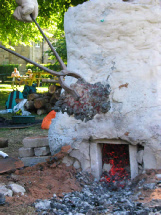Gerry McDonnell
Archaeometallurgy
The Bloomery Process - is it a solid state process?
It is commonly accepted that ‘the bloomery process’ was a solid state process. This is based on a number of factors
1 Percy’s observation of traditional ironworking reported by explorers in the 19th century.
2 The observation that most iron artefacts are manufactured from ferritic iron (i.e. pure iron) which has a smelting point of 1538oC, temperatures impossible to achieve in early furnaces.
3 Furnaces could not achieve temperatures sufficient to melt alloyed or pure iron.
There are some long standing doubters e.g. Strauber, Bjorkenstam, and Schuster (see Pleiner 2004 p??? ).

The evidence strongly supports some liquidity in the process, not least the evidence of high metal slags from sites, and the melting point of slags. Certainly the 12-14th Century furnaces of Rievaulx Abbey produced cast iron. This is not to say that all ‘bloomery’ processes from the Iron Age onwards involved liquidity, that has to be investigated.







